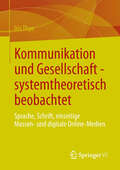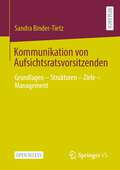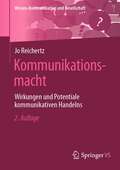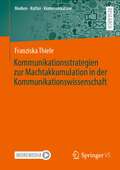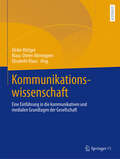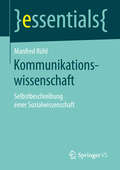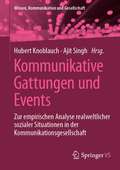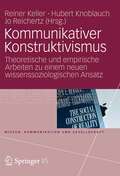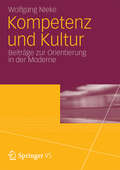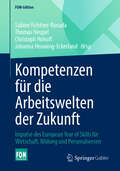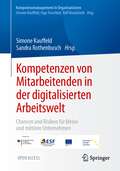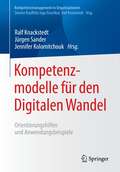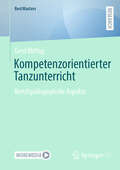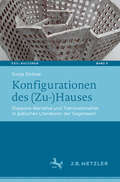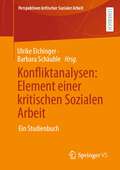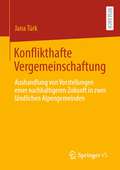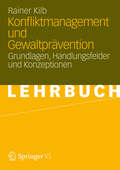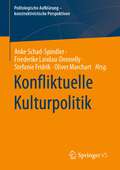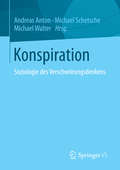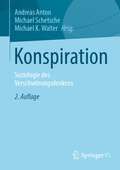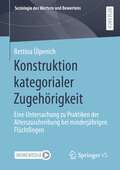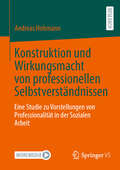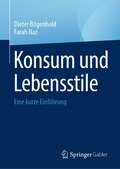- Table View
- List View
Kommunikation und Gesellschaft - systemtheoretisch beobachtet: Sprache, Schrift, einseitige Massen- und digitale Online-Medien
by Iris ThyeDieses Buch setzt sich in wissenschaftlicher Exegese mit dem von Niklas Luhmann konstituierten systemtheoretischen Begriff der Kommunikation auseinander. Eine evolutionär angelegte Analyse der verschiedenen Kommunikationsmedien folgt der begriffstechnisch präparierten Leitfrage, welche Veränderungen Sprache, Schrift, einseitige Massen- und digitale Online-Medien bei den drei basalen Komponenten der Kommunikation - Information, Mitteilung, Verstehen - bewirken. Wenn Kommunikation mit Luhmann als die grundlegende soziale Operation zu verstehen ist, die Gesellschaft allererst konstituiert, dann lässt sich zeigen, dass insbesondere technisch bedingte Umwälzungen in der Kommunikation - Buchdruck, elektronische Medien, Web 2.0 - bahnbrechende Veränderungen in der Gesellschaft, ihren Strukturen und Semantiken begünstigen und vorantreiben.
Kommunikation von Aufsichtsratsvorsitzenden: Grundlagen – Strukturen – Ziele – Management
by Sandra Binder-TietzIn diesem Open-Access-Buch präsentiert Sandra Binder-Tietz eine umfassende Analyse der Kommunikation von Aufsichtsratsvorsitzenden börsennotierter Unternehmen. Deren komplexe kommunikative Rolle wird dabei erstmals systematisch erschlossen. Aus der externen Perspektive werden die vielschichtigen Anforderungen der relevanten Stakeholder wie Investoren, Aktionärsschützer, Stimmrechtsberater und Journalisten an die Kommunikation aufgezeigt. Aus der internen Perspektive von Aufsichtsratsvorsitzenden, Investor-Relations- und Public-Relations-Verantwortlichen werden die internen und externen Kommunikationsmaßnahmen von Aufsichtsratsvorsitzenden identifiziert. Auf dieser Basis wird die Notwendigkeit begründet, warum und wie die Kommunikation zu einem festen Bestandteil des Kommunikationsmanagements von Unternehmen werden sollte. Für Forschung und Praxis werden dafür Implikationen und Empfehlungen entwickelt, wie eine erfolgreiche Kommunikation von Aufsichtsratsvorsitzenden aussehen kann.
Kommunikationsmacht: Wirkungen und Potentiale kommunikativen Handelns (Wissen, Kommunikation und Gesellschaft)
by Jo ReichertzKommunikatives Handeln kann Macht entfalten, kann anderen ein bestimmtes Handeln nahelegen, ohne dass direkter oder indirekter Zwang dahintersteht. Die Frage ist, weshalb kommunikatives Handeln auch ohne Gewalt und Herrschaft Macht haben kann. Eine Antwort auf diese Frage hat die Soziologie bislang noch nicht geben können. Hier wird eine Antwort entworfen, indem gezeigt wird, dass und wie alltägliche Kommunikationsmacht sich im kommunikativen Mit- und Gegeneinander erst aufbauen muss, um dann wirken zu können. Dabei kommen der Beziehung der Menschen zueinander, deren gegenseitige Anerkennung und die daraus folgenden Auswirkungen auf die Identität der Beteiligten eine besondere Bedeutung zu. Ein solches Verständnis der alltäglichen Macht von kommunikativem Handeln kann dabei auch helfen zu verstehen, wann und unter welchen Bedingungen Kommunikation in den privaten und öffentlichen (digitalen) Medien wirksam sein kann. Ein Verständnis kann jedoch auch dabei helfen, selbst über kommunikatives Handeln Wirkung zu erzielen bzw. sich gegen kommunikative Zumutungen zu wehren.
Kommunikationsstrategien zur Machtakkumulation in der Kommunikationswissenschaft (Medien • Kultur • Kommunikation)
by Franziska ThieleDauerstellen sind in der Wissenschaft rar gesät. Daher sind Nachwuchswissenschaftler*innen gut beraten, ihre Karriere strategisch zu planen und in ihrem Forschungsfeld frühzeitig sichtbar zu werden. In der Wissenschaft, wie auch in anderen gesellschaftlichen Bereichen, wird zur Erzeugung von Sichtbarkeit und Aufmerksamkeit zunehmend auf soziale Medien zurückgegriffen. Das wirft die Frage auf, ob es für eine wissenschaftliche Karriere mittlerweile notwendig ist, in sozialen Medien wie Blogs, Twitter, Facebook, Academia.edu oder ResearchGate präsent zu sein. Die Autorin dieser Arbeit untersucht dies anhand qualitativer Interviews mit Kommunikationswissenschaftler*innen. Sie vergleicht die Relevanz verschiedener Kommunikationsstrategien zur karrierebezogenen Machtakkumulation, wie das Schreiben von Publikationen, Halten von Vorträgen oder die Präsenz in den Massenmedien mit der Bedeutung der Nutzung sozialer Medien.
Kommunikationswissenschaft: Eine Einführung in die kommunikativen und medialen Grundlagen der Gesellschaft
by Elisabeth Klaus Ulrike Röttger Klaus-Dieter AltmeppenDieses Lehrbuch bietet Lehrenden, Lernenden und allen an öffentlicher Kommunikation Interessierten einen umfassenden Überblick über das Fach Kommunikationswissenschaft. Es informiert über dessen zentrale Theorien, Methoden und Forschungsfelder. Die Begriffe Medien, Öffentlichkeit und Kommunikation werden in ihrer Entwicklung bis hin zu den aktuellen digitalen Veränderungen analysiert. Die Beiträge des Lehrbuchs verdeutlichen das große Potenzial der Kommunikationswissenschaft, zur Analyse und Lösung gesellschaftlicher Wandlungsprozesse beizutragen. Zahlreiche didaktische Elemente und Abbildungen regen zum Stöbern und Weiterlesen an und machen das Buch zum stetigen Begleiter durch das Studium – vom Einstieg bis zur Prüfungsvorbereitung – und für alle weiteren Interessierten zu einem hilfreichen Werk, um sich die Prozesse und Strukturen der öffentlichen Kommunikation zu erschließen. Die Beiträge eröffnen multiperspektivische Blicke auf die verschiedenen Paradigmen und Modelle der Kommunikationswissenschaft. Damit verbunden ist ein hoher Nutzwert für Bachelor- und Masterstudierende der Kommunikationswissenschaft und angrenzender Fächer sowie für alle an Medien, Kommunikation und Öffentlichkeit interessierten Laien.
Kommunikationswissenschaft: Selbstbeschreibung einer Sozialwissenschaft (essentials)
by Manfred RühlEine Theorie der Kommunikationswissenschaft als Funktionssystem der Weltgesellschaft gibt es bisher nicht. Neu ist die Unterscheidung und die Synthese der sechs Kommunikationskomponenten Sinn, Information, Thema, Mitteilung, Gedächtnis und Verstehen, die Kommunikation unter mitweltbedingten Einschränkungen ermöglichen. Für die Funktion, die Kommunikationswissenschaft von anderen Funktionssystemen der Weltgesellschaft unterscheidet, wird das Erneuern bewahrten Kommunikationswissens vorgeschlagen.
Kommunikative Gattungen und Events: Zur empirischen Analyse realweltlicher sozialer Situationen in der Kommunikationsgesellschaft (Wissen, Kommunikation und Gesellschaft)
by Ajit Singh Hubert KnoblauchDer Band versammelt eine Reihe von soziologischen, linguistischen und kommunikationswissenschaftlichen Beiträgen, die kommunikative Gattungen und Events in der Gegenwartsgesellschaft untersuchen. Mit diesen Beiträgen verfolgt der Band mehrere Ziele. Zum einen zeigt er, wie ertragreich noch immer die vor über 30 Jahren entwickelte Analyse kommunikativer Gattungen ist. Wie eine Reihe von Arbeiten zeigen, lässt sie sich, zweitens, auch auf die mediatisierten Formen der Kommunikation anwenden, die sich im Zuge der jüngeren Digitalisierungswelle ausgebildet haben. Im Unterschied zu den zumeist rekonstruktiven Verfahren der Sozialwissenschaft zeichnet sie sich vor allem durch in situ erzeugte und damit hochgradig valide Prozessdaten aus, die nicht wesentlich von den Forschenden diktiert sind, sondern die untersuchten Abläufe im Datenmaterial dokumentieren. Ihr methodologischer Fokus auf realweltliche Praktiken, Handlungsabläufe und Kommunikationsprozesse hat, drittens, einen besonderen Forschungsfokus erzeugt, der sich um das kreist, was als „Event“ bezeichnet werden kann. Neben zahlreichen empirischen Beiträgen enthält der Band auch einige Beiträge, die die Konzepte der Gattung und des Events systematisch darstellen.
Kommunikativer Konstruktivismus
by Hubert Knoblauch Jo Reichertz Reiner KellerDie Welt wartet nicht dort draußen darauf, entdeckt zu werden, sondern wir schaffen sie Tag für Tag neu - und zwar vor allem mittels kommunikativen Handelns. Deshalb ändert sich die Wirklichkeit tagtäglich und mit ihr auch die soziale Ordnung und die Normen und Werte, die unserem Handeln Bedeutung verleihen. Das ist die Grundposition des hier vorgestellten Kommunikativen Konstruktivismus. Die versammelten Beiträge versuchen zum einen, den Ansatz des kommunikativen Konstruktivismus theoretisch zu begründen. Zum zweiten wird der Ansatz in empirischen Arbeiten umgesetzt, die sich mit den unterschiedlichen Themen in verschiedenen soziologischen Teildisziplinen (Wissenschaftssoziologie, Migrationssoziologie, Mediensoziologie) beschäftigen. Zum dritten beinhaltet der Band Arbeiten, die Anschlüsse zu anderen Disziplinen herstellen, wie etwa zu der Stadt- und Regionalplanung, der Organisationsforschung und der Kommunikationswissenschaft.
Kompetenz und Kultur
by Wolfgang NiekeIm Zentrum des Bandes stehen die Kernthemen 'Kompetenz' und 'Kultur' in ihrer Bedeutung für pädagogische Handlungskontexte. Die verschiedenen Facetten der Thematik werden über den Begriff der Handlungskompetenz entwickelt, wodurch neue Ansätze und Analysemöglichkeiten zu einer interkulturellen Erziehung aufgezeigt werden.
Kompetenz und Kultur: Beiträge zur Orientierung in der Moderne
by Wolfgang NiekeIm Zentrum des Bandes stehen die Kernthemen 'Kompetenz' und 'Kultur' in ihrer Bedeutung für pädagogische Handlungskontexte. Die verschiedenen Facetten der Thematik werden über den Begriff der Handlungskompetenz entwickelt, wodurch neue Ansätze und Analysemöglichkeiten zu einer interkulturellen Erziehung aufgezeigt werden.
Kompetenzen für die Arbeitswelten der Zukunft: Impulse des European Year of Skills für Wirtschaft, Bildung und Personalwesen (FOM-Edition)
by Johanna Heuwing-Eckerland Thomas Heupel Sabine Fichtner-Rosada Christoph HohoffDieses Buch beschäftigt sich mit dem bildungspolitischen Facettenreichtum beruflicher wie persönlicher Skills. Die Notwendigkeit, in einem sich wandelnden Arbeitsumfeld neu benötigte Kompetenzen zu definieren und zu vermitteln bzw. zu erlernen, wirft vielfältige Fragestellungen auf. Die Herausforderungen für Unternehmen, Bildungsanbieter und Arbeitnehmende werden aus wissenschaftlicher ebenso wie aus praxisorientierter Sicht reflektiert, um konkrete Erkenntnisse für Arbeitsalltag und Geschäftsmodelle abzuleiten. Die Autorinnen und Autoren betrachten unter anderem folgende Fragen: Welche Bedeutung hat der Wandel für den Erwerb, die Zertifizierung und die Aktualisierung von Kompetenzen? Wie können Deutschland und die EU strategisch mit diesem Wandel umgehen? Und welche Anforderungen ergeben sich daraus für das Bildungssystem und die Wirtschaft? Arbeitskräfte, die in einem stark gewandelten Arbeitsumfeld über die aktuell notwendigen und neu definierten Qualifikationen verfügen, tragen zu einem nachhaltigen Wachstum bei, fördern Innovationen und verbessern die Wettbewerbsfähigkeit der Unternehmen. Dies ist der Schlüssel, um sicherzustellen, dass der wirtschaftliche Aufschwung sowie der grüne und digitale Wandel sozial und gerecht sind. Vor diesem Hintergrund hat die Europäische Kommission das Jahr 2023 zum European Year of Skills erklärt.
Kompetenzen von Mitarbeitenden in der digitalisierten Arbeitswelt: Chancen und Risiken für kleine und mittlere Unternehmen (Kompetenzmanagement in Organisationen)
by Simone Kauffeld Sandra RothenbuschDieses Fachbuch betrachtet aus einer anwendungsorientierten Perspektive aktuelle und zukünftig nötigte Kompetenzen von Mitarbeitenden im Hinblick auf die fortschreitend digitalisierte Arbeitswelt. Es bietet ausgewählte wissenschaftlich fundierte und praxisnahe Einblicke in das Kompetenzmanagement von kleinen und mittleren Unternehmen, indem es Kompetenzmodelle sowie Unterstützungsmaßnahmen des formalen und informellen Lernens v. a. mittels digitaler Möglichkeiten präsentiert und diskutiert. Die anschaulich beschriebenen Anwendungsbeispiele zeigen innovative Maßnahmen auf, die bedeutsame Impulse für die eigene Praxis bieten können.Dies ist ein Open-Access-Buch.
Kompetenzmodelle für den Digitalen Wandel: Orientierungshilfen und Anwendungsbeispiele (Kompetenzmanagement in Organisationen)
by Jürgen Sander Ralf Knackstedt Jennifer KolomitchoukDas Fachbuch bietet Orientierungshilfe bei der Analyse der Kompetenzanforderungen im Digitalen Wandel. Es stellt Kompetenzmodelle unterschiedlicher Ausrichtungen vor und dient als Ausgangsbasis für die Profilbildung in der eigenen Organisation. Schwerpunkte sind Computational Thinking, Informationskompetenz, Künstliche Intelligenz und ethische Reflexion. Die Anforderungen dienen als Basis für die Konzeption einer passgenauen Kompetenzentwicklung für den Digitalen Wandel. Anschaulich präsentierte Anwendungsbeispiele regen die Umsetzung innovativer Maßnahmen im Umfeld der eigenen Organisation an.
Kompetenzorientierter Tanzunterricht: Berufspädagogische Aspekte (BestMasters)
by Gerd MittagDie Studie untersuchte im deutschsprachigen Raum, inwieweit Lehrkräfte freier (nicht akademisierter) Tanzarten – hier stellvertretend die Middle Eastern Dances (MED) - durch kompetenzorientierte Unterrichtsmethoden die Befriedigung basispsychologischer Bedürfnisse (Autonomie, Kompetenz und Verbundenheit) von Tanzlernenden auf der Grundlage der Bedürfnispyramide von Maslow und der Motivationstheorie von Deci und Ryan unterstützen können. Die Ergebnisse der durchgeführten Mixed-Methods-Studie schließen eine historische Informationslücke hinsichtlich erster MED-Ausbildungen im deutschsprachigen Markt. Weitere Analyseresultate der Studie zeigen starke evidenzbasierte Argumente für kompetenzorientierte Unterrichtsmethoden als Unterstützung für die Befriedigung basispsychologischer Bedürfnisse der Lernenden. Der Autor fasst die Ergebnisse in einem Modell reziproker triangulärer Interaktionen zusammen und zeigt die Potenziale kompetenzorientierten Unterrichts auf.
Kon-Tiki: Across the Pacific by Raft
by Thor HeyerdahlThis book recounts a groups' travels across the Pacific ocean on a raft
Konfigurationen des: Diaspora-Narrative und Transnationalität in jüdischen Literaturen der Gegenwart (Exil-Kulturen #3)
by Sonja DickowDie komparatistische Studie arbeitet anhand von Parallellektüren deutsch-, englisch- und hebräischsprachiger Gegenwartstexte den Befund heraus, dass gerade an der Konfiguration des immobilen Hauses Mehrfachverortung und Grenzüberschreitung verhandelt werden. Das Zuhause verliert durch die Zerstörungen der Shoah und die Exilerfahrungen der jüdischen Figuren seine Funktion als Heimat und Ort der Stabilität und Kontinuität. Erinnerndes Erzählen und Traditionen des diasporischen Schreibens werden dagegen als Orte der Zugehörigkeit diskutiert. Der in der mehrsprachigen jüdischen Literaturgeschichte ohnehin angelegte Transnationalitätsdiskurs wird in Untersuchungen zu Nicole Krauss und Anna Mitgutsch, Jenny Erpenbeck und Eshkol Nevo, Michal Govrin und Barbara Honigmann aufgerufen.
Konfliktanalysen: Ein Studienbuch (Perspektiven kritischer Sozialer Arbeit #32)
by Ulrike Eichinger Barbara SchäubleDas Buch stellt Konflikte aus verschiedenen Arbeitsbereichen Sozialer Arbeit vor, die subjekt- und bereichsorientiert mittels unterschiedlicher konflikttheoretischer und -methodischer Ansätze ausgeleuchtet werden. Zudem werden Formen der Konfliktbearbeitung analysiert. Hierdurch wird die Vielfalt und das Potenzial konfliktanalytischer Perspektiven für das Studium zugänglich(er) gemacht und das Orientieren in arbeitsbereichsspezifischen Widersprüchen für eine kritische (Professionalisierungs-)Praxis unterstützt.
Konflikthafte Vergemeinschaftung: Aushandlung von Vorstellungen einer nachhaltigeren Zukunft in zwei ländlichen Alpengemeinden
by Jana TürkJana Türk untersucht in ihrer qualitativen Studie, wie Akteure in zwei ländlichen Alpengemeinden nachhaltige Entwicklung aushandeln. Dabei nimmt sie unterschiedliche lokale Entwicklungsprozesse in den Blick und rekonstruiert anhand von leitfadengestützten Interviews, ethnographischen Beobachtungen und weiteren Dokumenten kollaborative und konflikthafte Aushandlungsprozesse und welche Rolle Gemeinwohl im Umgang mit den lokal wirksamen Dynamiken sozial-ökologischen Wandels spielt.
Konfliktmanagement und Gewaltprävention
by Rainer KilbKonfliktbearbeitung und Gewaltprävention sind heute zentrale Aufgaben in zahlreichen Handlungsfeldern von Sozialer Arbeit aber auch des schulischen Alltags. Ein professioneller Umgang mit dem Phänomen zählt somit zu den erwarteten Handlungskompetenzen der pädagogischen Fachkräfte und sollte bereits im Studium vermittelt, erprobt und auch trainiert werden. Das Buch vermittelt die theoretischen Grundlagen als auch eine Übersicht wichtiger Konzeptionen und Handlungsansätze.
Konfliktuelle Kulturpolitik (Politologische Aufklärung – konstruktivistische Perspektiven)
by Oliver Marchart Anke Schad-Spindler Friederike Landau-Donnelly Stefanie FridrikDieser Sammelband vereint Beiträge aus unterschiedlichen Bereichen der Kulturpolitikforschung. Impulsgebend für den Band war das Forschungsprojekt „Agonistische Kulturpolitik (AGONART) – Fallstudien zur konfliktiven Transformation von Kulturstandorten“. Dieses verstand sich als interdisziplinärer Beitrag zwischen qualitativ-empirischer Grundlagenforschung in Politikwissenschaft (mit Schwerpunkt auf Kulturpolitik) und politischer Theorie (mit Schwerpunkt auf Konflikttheorie bzw. agonistischer Demokratietheorie). Das Buch regt somit zu einer wissenschaftlichen Auseinandersetzung mit Kulturpolitik(forschung) in Österreich, dem deutschsprachigen Raum und darüber hinaus an.
Konspiration
by Andreas Anton Michael Schetsche Michael K. WalterVerschwörungstheorien genießen in der Bevölkerung große Popularität. In den Wissenschaften haben sie hingegen einen eher schlechten Ruf - den Leitmedien gelten sie als Ausdruck überzogenen politischen Misstrauens oder gar kollektiver Paranoia. Der vorliegende Band erklärt, wie diese unterschiedliche Bewertung zustande kommt und woraus der anhaltende Erfolg von Verschwörungstheorien in der Öffentlichkeit resultiert. Mittels empirischer Fallstudien, medienwissenschaftlicher Rekonstruktionen und theoretischer Reflexionen wagt der Band den Versuch einer soziologischen Ehrenrettung des konspirologischen Gegenwartsdenkens.
Konspiration: Soziologie des Verschwörungsdenkens
by Andreas Anton Michael Schetsche Michael K. WalterSpätestens seit der Corona-Pandemie werden Verschwörungstheorien zunehmend als gesellschaftspolitisches Problem wahrgenommen und sind zum Politikum geworden. Wohl noch nie zuvor gab es im öffentlichen Diskurs eine derart hohe Sensibilität für das Thema. Ängste vor Verschwörungen einerseits und Ängste vor Verschwörungstheorien andererseits schaukeln sich offenbar gegenseitig hoch. Dies führt zu einer anwachsenden gesellschaftlichen Polarisierung und zu einem Klima von Misstrauen, Empörung und Gereiztheit. Zehn Jahre nach der Erstauflage des vorliegenden Bandes erscheint die Analyse des gegenwärtigen Verschwörungsdenkens dringender denn je. Im Rahmen von sechs neuen Beiträgen nimmt die erweiterte Neuauflage aktuelle Entwicklungen in den Blick. In Kombination mit den ursprünglichen Aufsätzen soll so zu einem umfassenden und differenzierten Bild des sozialen Phänomens Verschwörungstheorien beigetragen werden.
Konstruktion kategorialer Zugehörigkeit: Eine Untersuchung zu Praktiken der Alterszuschreibung bei minderjährigen Flüchtlingen (Soziologie des Wertens und Bewertens)
by Bettina ÜlpenichDie Inobhutnahme nach unbegleiteter Einreise aus dem Ausland wird im Zuge aktueller Migrationsbewegungen zu einer Hauptaufgabe deutscher Jugendämter. Diese haben in der Inobhutnahme zu prüfen, wem die Maßnahmen der Jugendhilfe rechtmäßig zukommen. Alterszuschreibungen werden in diesem Kontext zu einer kritischen Bewertung, die Jugendliche zum Teil der Personenkategorie der unbegleiteten minderjährigen Flüchtlinge macht und andere davon ausschließt.Diese soziologische Analyse macht sich das administrative Verfahren der Inobhutnahme zum Gegenstand und fragt, wie Personen Teil obiger Personenkategorie werden. Inobhutnahmen nach unbegleiteter Einreise aus dem Ausland erscheinen hier als aktiv hervorgebrachter und konfliktiver Zuschreibungsprozess, dessen jeder neue Schritt neue Unsicherheiten erzeugt und jeder Beobachtung eine Vorläufigkeit einschreibt. Anhand der wissenssoziologischen Rekonstruktion von Einsichtnahmen in Ausweispapiere, Inaugenscheinnahmen und ärztlichen Untersuchungen macht die Analyse die administrative Realisierung von Ordnung sichtbar. Alterszuschreibungen erfolgen hier vor dem Hintergrund und in Auseinandersetzung mit westlich-hegemonialen Ideen über das Alter einer Person. Die Analyse des Inobhutnahmeverfahrens verhilft damit einem Merkmal zu Sichtbarkeit, über das Personen nur unter ganz bestimmten Umständen verfügen können.
Konstruktion und Wirkungsmacht von professionellen Selbstverständnissen: Eine Studie zu Vorstellungen von Professionalität in der Sozialen Arbeit
by Andreas HohmannKanonische Studien im Professionalisierungsdiskurs der Sozialen Arbeit legen den Schluss nahe, dass nicht vorausgesetzt werden kann, dass Hochschulabsolvent*innen einschlägiger Fachstudiengänge der Sozialen Arbeit die Entwicklung von Professionalität per se als sinnhaftes berufliches Entwicklungsziel für sich akzeptieren. Das bedeutet jedoch nicht, dass Professionalität für Praktiker*innen per se kein relevantes Thema darstellt. Anzunehmen ist eher, dass Professionalität für sie mit spezifischen Relevanzen besetzt ist. Der Autor rekonstruiert in dieser qualitativen Studie mit einer Triangulation von zwei hermeneutischen Methoden, wie Praktiker*innen der Sozialen Arbeit ihr professionelles Selbstverständnis als subjektive Vorstellungen von Professionalität narrativ konstruieren. Das Interesse der Studie gilt darüber hinaus der Frage, welche bildhaften Sinnstiftungsmuster diese Konstruktion sinnhaft anleiten. Der Blick auf professionelle Selbstverständnisse als Sinnkonstruktionen und Ordnungsleistungen des Individuums schärft den Blick dafür, unter welchen Bedingungen Professionalität für Praktiker*innen der Sozialen Arbeit zu einem sinnstiftenden Projekt wird, in das es sich in Form von Zeit, Energie, Fortbildung, Reflexion, etc. zu investieren lohnt. Die Arbeit elaboriert den Begriff des professionellen Selbstverständnisses als analytisches Konzept für den Professionalisierungsdiskurs Sozialer Arbeit.
Konsum und Lebensstile: Eine kurze Einführung
by Dieter Bögenhold Farah NazIn diesem Buch wird ein interdisziplinärer Ansatz für die Welt des Konsums gewählt, der verschiedene Themen abdeckt und soziologische, wirtschaftliche und marketingbezogene Aspekte einbezieht. Der Begriff "Konsum" ist vage, und selbst in den akademischen Disziplinen wird der Begriff auf unterschiedliche Weise verwendet. Die Konsumforschung fragt, wie Einkommen und Ausgaben miteinander zusammenhängen. Ganz allgemein untersucht die Konsumforschung, wie Menschen, soziale Schichten oder Gesellschaften ihre Konsumgewohnheiten realisieren. Häufig wird die Frage gestellt, wie konsistent Präferenzstrukturen aufgrund wechselnder empirischer Hintergründe von Zeit, Raum und damit verbundener Kultur sind. Welche Kontextvariablen (historischer Zeitpunkt, geographischer Rahmen, kultureller Hintergrund) spezifizieren die Praxis des Konsums und in welcher Weise haben Merkmale wie Alter, Geschlecht, Klasse, Beruf und Lebensstil eigene Auswirkungen auf die Art und Weise, wie Konsum realisiert wird?Das Buch ist für Forscher aus den Bereichen Ökonomie, Soziologie, Marketing, Ästhetik und Design, Anthropologie und Kommunikationswissenschaft von Interesse.
